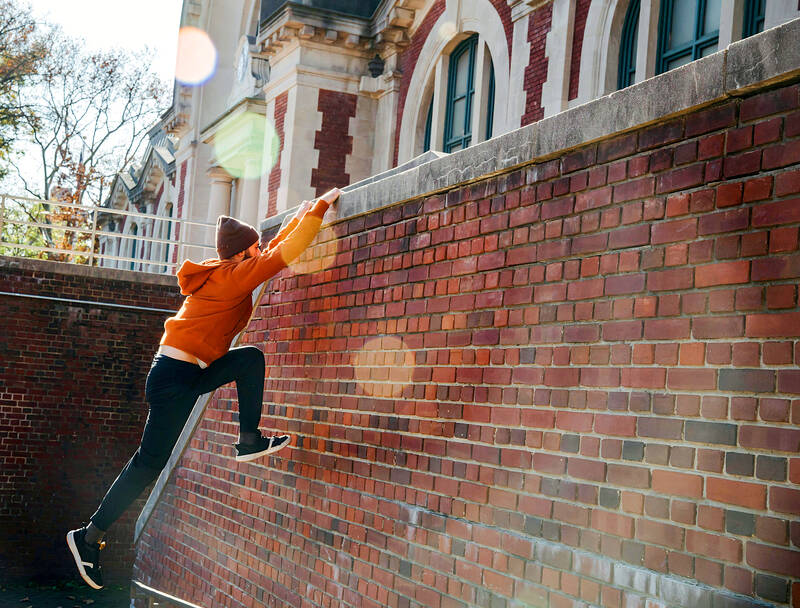Have you ever dreamed of using an entire city as your training ground, effortlessly moving across walls, buildings, stairs, and obstacles? This is not just a fantasy from the movies. In cities around the world, a group of enthusiasts practice this seemingly impossible sport — “parkour.”
The origins of parkour can be traced back to 20th-century France. A military officer named Georges-Hebert witnessed the incredible physical abilities of local residents in Africa, which inspired him to create the Methode Naturelle, or natural method. This training method cleverly combined climbing, running, and swimming with artificial barriers to mimic nature. Later, David Belle evolved this into parkour as we know it today. His father, Raymond, crucially influenced its development and taught David that with total conviction, anything is possible.
At its core, parkour is about overcoming obstacles in an environment while developing one’s capabilities. Basic movements include running, jumping, climbing, and rolling. However, parkour is not limited to fixed moves. Practitioners, commonly called traceurs, can develop unique skills based on the environment and their personal abilities. In addition, safety is always a top priority in parkour. Beginners should learn gradually under professional guidance and avoid risky moves done for mere excitement.

Photo: Pexels 照片:Pexels 提供
The charm of parkour lies not in the flashy moves or the display of high-difficulty skills. Its true essence is that every jump and climb is a challenge and a breakthrough for self-belief.
你是否曾經夢想過把整個城市當作一個大訓練場,輕鬆地在牆壁、建築、樓梯、障礙物間自由穿梭?這並非只存在於電影中的幻想。在世界各地的城市中,有一群熱衷此道的人練習著這項看似不可能的運動─跑酷。
跑酷的起源可追溯至20世紀的法國。當時一位名叫喬治.赫伯的軍官在非洲見證了當地居民的驚人體能,啟發他建立了一套全新訓練方法,叫做大自然訓練法。這種訓練法巧妙地結合了攀爬、奔跑、游泳等技能,並透過人工設置的障礙物來模擬自然環境。這套方法後來被大衛.貝爾發展成現今所知的跑酷。大衛的父親,雷蒙德.貝爾,對跑酷的發展有著至關重要的影響,並教導大衛只要有絕對的信念,任何事情都有可能。
跑酷的核心在於克服環境中的障礙,同時培養自身的能力。基本動作包括跑、跳、攀爬和翻滾等。然而,跑酷並不侷限於固定的招式。從事跑酷活動的人可以根據環境和個人能力發展獨特的技巧。此外,安全永遠是跑酷的首要考量。初學者應該在專業指導下循序漸進地學習,避免為了追求刺激而冒險嘗試危險動作。
跑酷的魅力不在於浮誇的動作或是高難度的技巧呈現。它的真諦在於每一次跳躍和攀爬都是對自我信念的一次挑戰和突破。
MORE INFORMATION
flashy adj. 艷俗的;浮華的
KEY VOCABULARY
1. effortlessly adv. 毫不費力地;輕鬆地
Bradley swung at the baseball and effortlessly hit it high into the sky.
布萊德利揮動球棒擊球,毫不費力地擊中球,使它高高地飛向天空。
2. be traced back to 追溯到……
Robert’s fear of water can be traced back to an accident in which he almost drowned.
羅伯特對水的恐懼可以追溯到他差點溺水的事故。
3. artificial adj. 人工的;人造的
These are artificial flowers; that’s why they don’t have any scent. 這些是人造花;這就是為什麼它們沒有任何氣味。
4. mimic vt. 模仿;模擬
My parrot can mimic my phone’s ringtone perfectly. He fools me every time he does it!
我的鸚鵡可以完美地模仿我的手機鈴聲。每次他這麼做都會騙到我!
5. practitioner n. 從事特定活動或職業的人
Camilla has been a practitioner of karate since she was five, and now she’s at the master level.
卡蜜拉從五歲開始當空手道家,而今她是大師級。
6. guidance n. 指導;引導
The students looked to their teacher for guidance on how to complete the project.
學生們向他們的老師尋求有關如何完成專案的指導。
7. risky adj. 有風險的;冒險的
It could be risky to do business with Bruce; he was caught lying about his taxes recently.
與布魯斯一起做生意可能有風險;他最近被抓到在稅務上作假。
學習音檔: https://magazine.english4u.net/Magdata/menu/krnc3
《空中美語》雜誌APP免費下載: https://www.english4u.net/apps/index.aspx
免費收聽當月《空中美語》雜誌課文朗讀及解析 !
文章由AMC空中美語授權使用: https://www.english4u.net

In an effort to fight phone scams, British mobile phone company O2 has introduced Daisy, an AI designed to engage phone con artists in time-wasting conversations. Daisy is portrayed as a kindly British granny, exploiting scammers’ tendency to target the elderly. Her voice, based on a real grandmother’s for authenticity, adds to her credibility in the role. “O2” has distributed several dedicated phone numbers online to direct scammers to Daisy instead of actual customers. When Daisy receives a call, she translates the scammers’ spoken words into text and then responds to them accordingly through a text-to-speech system. Remarkably, Daisy

Bilingual Story is a fictionalized account. 雙語故事部分內容純屬虛構。 Emma had reviewed 41 resumes that morning. While the ATS screened out 288 unqualified, she screened for AI slop. She could spot it a mile away. She muttered AI buzzwords like curses under her breath. “Team player.” “Results-driven.” “Stakeholder alignment.” “Leveraging core competencies.” Each resume reeked of AI modeling: a cemetery of cliches, tombstones of personality. AI wasn’t just changing hiring. It was draining the humanity from it. Then she found it: a plain PDF cover letter. No template. No design flourishes. The first line read: “I once tried to automate my

Every May 1, Hawaii comes alive with Lei Day, a festival celebrating the rich culture and spirit of the islands. Initiated in 1927 by the poet Don Blanding, Lei Day began as a tribute to the Hawaiian custom of making and wearing leis. The idea was quickly adopted and officially recognized as a holiday in 1929, and leis have since become a symbol of local pride and cultural preservation. In Hawaiian culture, leis are more than decorative garlands made from flowers, shells or feathers. For Hawaiians, giving a lei is as natural as saying “aloha.” It shows love and

1. 他走出門,左右看一下,就過了馬路。 ˇ He walked outside, looked left and right, and crossed the road. χ He walked outside and looked left and right, crossed the road. 註︰並列連接詞 and 在這句中連接三個述語。一般的結構是 x, y, and z。x and y and z 是加強語氣的結構,x and y, z 則不可以。 2. 他們知道自己的弱點以及如何趕上其他競爭者。 ˇ They saw where their weak points lay and how they could catch up with the other competitors. χ They saw where their weak points lay and how to catch up with the other competitors. 註:and 一般連接同等成分,結構相等的單詞、片語或子句。誤句中 and 的前面是子句,後面是不定詞片語,不能用 and 連接,必須把不定詞片語改為子句,and 前後的結構才相等。 3. 她坐上計程車,直接到機場。 ˇ She took a cab, which took her straight to the airport. ˇ She took a cab and it took her straight